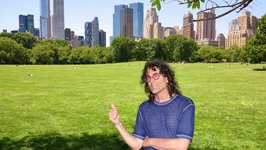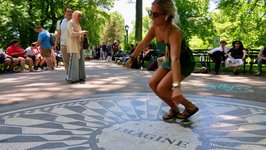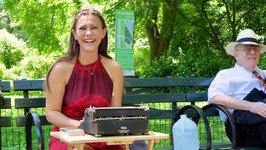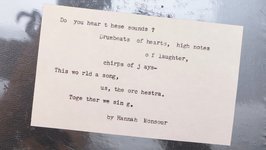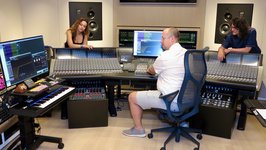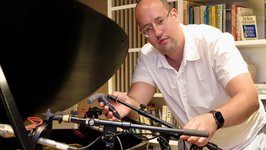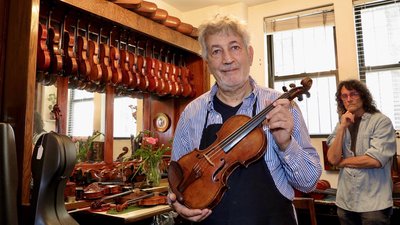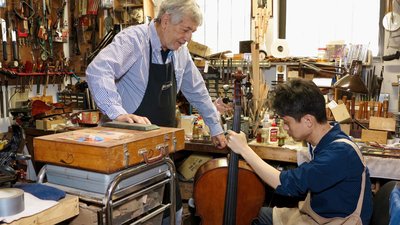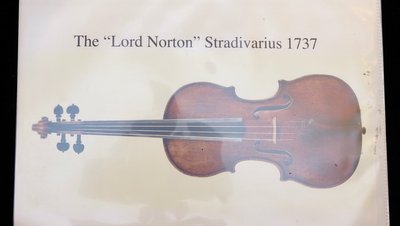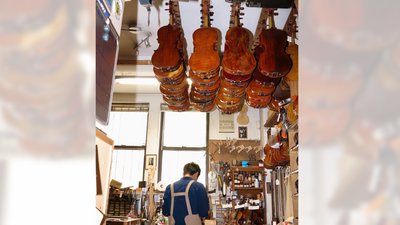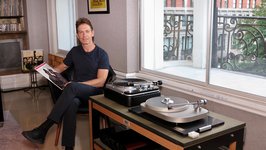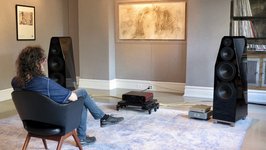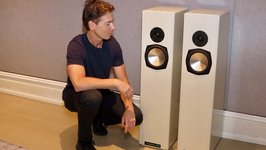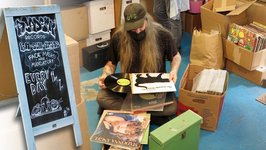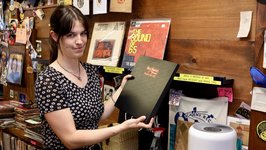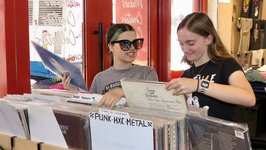
Story: Hi-Fi in New York
An Audiophile Tour Through New York City
Let‘s go on a trip! – Hardly anyone knows New York‘s "sound hot spots" better than David Chesky. The label boss and sound guru, known for his high-class recording quality, took us on a euphonic tour through downtown NYC. And he meant the walking part literally...
It all starts rather harmlessly: Thanks to our "Sound Education Sessions" at Edgemont Junior/Senior High School – see here – we are close by and decide to meet up with David Chesky from the legendary label Chesky Records in New York‘s Central Park. He knows about the city‘s music hot spots like no other. Suddenly, he points his thumb toward the skyline and says, "How about a trip to places you‘d never get to otherwise?" Of course, what could be better than being shown around by an expert? And off we go.
Before the urban jungle swallows us up, we pay a visit to the Strawberry Fields. A small area on the edge of Central Park that commemorates John Lennon, who was shot across the street outside his front door in 1980. For many people, the world collapsed right then and there. As a place of peace as well as to remember the great Beatle, his widow Yoko Ono donated this memorial, which was inaugurated in ᾽85 and bears the name of the famous Lennon song: "Strawberry Fields".
On Holy Ground
To this day, devoted Beatles fans as well as just about everyone else gathers here for a few quiet, contemplative moments in the spirit of the old days. A street musician sits on a bench and plays "Blowin' In The Wind." A special mood is in the air. Everyone pauses for a moment, letting their thoughts drift away. We are also caught up in it.
But suddenly we look into a smiling face. A young woman has set up her typewriter on a folding table and offers "Poetry For Strangers"; the student Hannah Monsour. "Do you want a poem?" she calls over. Well, of course we do, but it has to have something to do with music and sound, because that's what it's all about for us.
Right away, the keys are clattering and – whoosh! – she pulls a flat strip of paper out of the ancient device: our own personal poem! On this "holy ground", quite a lot is possible. Lost in thought, a tourist staggers around the central mosaic with the "Imagine" inscription. Well, all the things that could have been... David snaps us out of our daydreams. Now we really get going.
We walk for quite a while through the urban canyons. Fortunately, there is something interesting to see at every corner. Then we enter an ordinary building at 100 West 80th Street. In the basement, the young "Precision Sound Studio" of Alex Sterling is located. He learned his craft at Chesky Records before starting his own studio.
And Alex took his quality standards with him from there. "We usually record in PCM format 24 bit/96 kilohertz," he states, "with acoustic music preferably even higher to get an extra slice of realism." "We do everything for top quality!" In other places, production happens in just about any supplied format, because "not everything that ends up in a studio started in a studio," as Sterling comments on the home recording scene.
Recording in Progress!
Immediately, we arrive at the provoking topics of dynamic compression and the "loudness war", i.e. the urge to produce music as "loud" as possible. In addition to the dynamics of an attention-seeking music market for pop, Alex also sees aesthetic reasons for the trend toward dynamic flattening: "It has to do with captivating the listener, with the sonic density that compression creates, and sometimes also with a certain aggressiveness that can be specifically promoted in this way, along with intended distortions." This topic thus also includes tonal as well as musical stylistic devices.
Audiophiles often argue from a reference point, Sterling says, and have the dynamics of an orchestra or a jazz band in mind. But amplified music follows different principles and must be treated accordingly: "An electric guitar doesn't have a lot of dynamics anyway."
The sound engineer cautions not to focus solely on dynamics: "There's so much more to music than loud and quiet." But he also recognizes that for some producers, the drive for reach and attention overrides the goal of maintaining natural dynamics.
The conversation turns to the fact that the recording engineer ultimately determines the sound quality much more than any streaming device, amplifier or loudspeaker. The hi-fi fan has to live with this realization.
In order to reinforce his statement and not just dwell on the theoretical, the studio boss has prepared something for us: a comparison between three microphones that are mounted in the singer's booth in such a way that their capsules are at exactly the same height, directly next to each other. These are exclusively large-diaphragm tube condenser models, which Sterling uses for vocal recordings depending on the timbre provided.
In the meantime, David Chesky's daughter Paloma has arrived, a talented young composer and singer, who immediately sits down in front of the mic trio. Her father sits next door at the piano. Everything comes together in Sterling's multi-channel mixing console. The family duo improvises for about two minutes on a blues motif and gets along so well musically that it all seems professional and prepared.
Immediately afterwards, we hear the result from the monitor speakers embedded into the wall, switching smoothly and without level jumps between the microphone tracks generated by the Coil Audio tube amps. Thus, Paloma sounds very natural and graceful from the Chandler REDD. Via Bock Audio's 251, her voice is even slightly clearer and cleaner, as well as almost a bit crystalline, which comes across as cooler and more distant in the emotional sense, as we do miss some charm. In contrast, the Manley Silver delivers the missing charm and a good deal of timbre on top. Not huge, but still clear differences.
Now Alex is fully in his element and gives us a taste of the infinite possibilities the console offers. "By equalization", i.e. adjustments in the frequency spectrum, "you can compensate for the errors of each microphone". Nevertheless, it is important to choose the highest quality at this point, because "the information that is missing from the start can hardly be recovered later." This argument also applies to hi-fi: the source device cannot be good enough. And in the studio, everything starts with the microphone. That was interesting, and the little workshop was fun. We say goodbye, as we still have a long way to go...
In Violin Heaven
It's indeed not that far to the next address, 74 West 68th Street. There, we descend a few steps from the busy street to the basement. A heavy steel door opens, we enter and suddenly find ourselves in another world. We are surrounded by string instruments, mainly violins. There is a scent of wood, warm colors dominate the atmosphere, a chandelier illuminates the scenery. All sense of stress immediately leaves the visitor. It is as if a time machine had transported us from the modern-day New York to an Eastern European city in the 19th century.
This is the realm of David Segal, who studied violin making in Cremona for four years in the early 1970s and is now nearing 50 years of running his business in New York. Originally, he wanted to stay only two years to learn instrument service at Wurlitzer ... A typical NYC story.
Segal's son, the conductor Yaniv Segal, has performed and recorded works by David Chesky and was enthusiastic about his compositional as well as audiophile and technological approach. Ever since he introduced him to his father, the two have also become close friends, and the shop, which seems to have come from another time, is Chesky's peaceful retreat from the busy city.
A calmer pulse beats here. Next door, in the workshop filled with a myriad of tools, strings, varnishes and other materials, this holds true as well. Here, employee Hideo Nagai is currently busy refurbishing a cello and the sky is literally full of violins.
Everything is as impressive as it is pleasant, but a real sensation is waiting for us: David Segal opens his safe and pulls out a violin that, at first glance, could be any violin. It is in fact "Lord Norton," presumably the last violin made by the master Antonio Stradivari in 1737. Its value is estimated to be at around ten million dollars.
It belongs to David Segal, who bought it years ago out of love and admiration, but also as an investment. "I could just as easily have invested in stocks or bought a prestigious townhouse, but I am a stranger to those topics. Here, I know what I have," comments the Israeli-born owner to our stunned faces. We never expected to come across such a gem, which we were even allowed to hold in our hands for a short time. Our tour guide smiles to himself, "Well, what do you say now?" Nothing, because we are absolutely speechless – and not to forget floored. Thanks to both Davids for this unique experience!
Hero of the HiFi Diaspora
At the other end of the city – for once we don't walk there, but take the subway – we discover a place that is fascinating in a completely different way. We're at 210 Fifth Avenue, Suite 301. No sign indicates that Gideon Schwartz runs his "Audioarts" hi-fi studio on the third floor here. Insiders know the address. Schwartz is a former lawyer who was tired of always quarreling and created this refuge of great sound.
Also special: in the land of big high-end brands, Schwartz exclusively has components from Germany and Switzerland. "Even at a young age, I was drawn to devices from these countries. There was and is something special in the articulation and musical approach that appeals to me. In my studio, I pursue the goal of deepening and cultivating the experiences of that time."
In the listening room, a Swissonor-revised Thorens TD124 sits next to a modern Thales turntable. A pair of carefully placed loudspeakers from Munich-based manufacturer Zellaton plays. They are driven by the Swiss Physics amp combo 5 and 6A from the early nineties. Both are completely overhauled, highly sought after and, according to Schwartz, pretty much priceless. Monetary matters, however, are secondary here anyway. He is more interested in the degree of artistry and aesthetics that has been achieved both technically and sonically.
The enthusiast puts a few records on the Thales for us. It sounds fantastic without any doubt – natural, lively and plastic at the same time. A few sizes smaller? Then we move on to Urs Wagner's "Ensemble" setup. Almost tenderly, Gideon Schwartz, who published a kind of standard work on the subject in 2019 with the book "Hi-Fi – The History of High-End Audio Design," runs his fingers over the lacquer of Symphonic Line's RG5 MK4. "This is one of my absolute favorite speakers and the last pair Rolf Gemein made," he muses with melancholy, "because the Podszus Görlich woofer is not available anymore." Here is someone with passion for the topic!
Secondhand Vinyl with Flair
We walk and walk and walk, catching a glimpse of the stylish home of saxophone legend Charlie Parker, and soon find ourselves in front of Academy Records, a well-stocked secondhand record store in Greenwich Village. In the middle of the entrance, someone with a hippie-look sits on the floor and sorts used vinyl. There are boxes everywhere, but the records are neatly arranged by genre. Okay, the typical atmosphere and plenty of records on offer, but that's not why we're here, is it? "Ah," David Chesky tilts his head, "this place just still lives the old New York spirit of 'fuck off!' 'get out!' and 'burn the flag!'" Huh, we wouldn't have expected so much gruff sentimentality from the mature label boss.
Another subway ride and quite a lot of further walking leads us to our "final destination". It is the apartment of Edgar Y. Choueiri. To long-standing German STEREO readers, he might not be a stranger. Back in 2013 and '16, we reported in detail on his remarkable "BACCH-SP" system, with which the physicist once again made waves at the 2022 HighEnd audio show. By measuring the listener's ears with intelligent, self-written algorithms such as sophisticated filters, it provides incredibly spatial listening impressions via speakers that come close to the artificial head experience via headphones.
Rocket Science for Spatial Sound
Right when Böde finally got the chance to sit down on the sofa and stretch out his tired legs, miniature measuring microphones were put into his ears. Via short signals from the two flat transducers positioned close together at a short distance in front of him, his individual hearing physiognomy is analyzed and stored. A head tracker additionally records the position of his head. Then it starts. We listen to the latest BACCH-SP version with refined software. It's almost unbelievable: what you hear and what you see have a curious relationship. Despite a narrow speaker base, a huge church aisle opens up in a choir recording; in an older jazz recording, the musicians are grouped around the tangibly depicted singer in an exactly localizable way. If you turn your head, everything stays in place. That's where stereo 3D sound becomes a fascinating experience somewhere between a look into the future and a carnival attraction.
But Choueiri takes it seriously. The scientist, who is a professor at Princeton University, where he primarily develops plasma propulsion systems for future space missions – NASA has just extended his research contract – is working in his "3D3D Research Lab" for Tesla on an innovative spatial imaging process in cars, as well as on a method for improving the perception of sound sources in noisy environments simply by looking at them. Unbelievable!
Enough! Stop! Finish! At the end of our New York trip we come close to the hi-fi overdose. Thanks, David, it was great! With tired feet, but full hearts we head back home.
 MAGAZINE
MAGAZINE